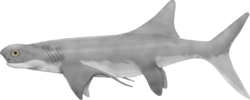Biology:Cobelodus
| Cobelodus | |
|---|---|

| |
| Life restoration | |
| Scientific classification | |
| Domain: | Eukaryota |
| Kingdom: | Animalia |
| Phylum: | Chordata |
| Class: | Chondrichthyes |
| Subclass: | Holocephali |
| Order: | †Symmoriiformes |
| Family: | †Symmoriidae |
| Genus: | †Cobelodus Zangerl, 1973 |
| Type species | |
| †Styptobasis aculeata Cope, 1894
| |
| Species | |
|
†C. aculeatus Cope, 1894 | |
Cobelodus is an extinct genus of holocephalid known from the late Carboniferous to the early Permian period.[1][2] The type specimen, assigned to the genus Styptobasis, was discovered by Edward Drinker Cope in Illinois Basin black coal shales. Rainer Zangerl reassigned S. aculeata in 1973 to the genus Cobelodus, translating to 'needle tooth'. Cope's description was based from a tooth fragment and was compared to the genus Monocladodus. Cobelodus differs from Styptobasis and Monocladodus in the anatomy of its teeth and pectoral fins.[1]
Cobelodus was an up to 1.5–2 metres (4.9–6.6 ft) long predator.[3] Although it was related to the chimaera, Cobelodus had a number of differences from modern forms. It had a bulbous head, large eyes, a high-arched back, and a dorsal fin placed far to the rear, above the pelvic fins. Another unusual physical feature of Cobelodus are the 30 centimetres (12 in) long, flexible cartilagenous 'tentacles' sprouting from its pectoral fins. Their purpose is unknown.[4] Type species, C. aculeatus is known from shoreline lagoon.[1][5]
References
- ↑ 1.0 1.1 1.2 Zangerl, Rainer (November 1976). "Cobelodus aculeatus (Cope), an anacanthous shark from Pennsylvanian black shales of North America". Palaeontographica: Beiträge zur Naturgeschichte der Vorzeit 154: 107–157. https://www.researchgate.net/publication/281136215. Retrieved 28 December 2021.
- ↑ Ivanov, Alexander (30 August 2005). "Early Permian chondrichthyans of the Middle and South Urals". Revista Brasileira de Paleontologia 8 (2): 127–138. doi:10.4072/rbp.2005.2.05. https://www.researchgate.net/publication/228487527. Retrieved 29 December 2021.
- ↑ Hodnett, John-Paul; Lucas, Spencer (2021). "REVIEW OF THE LATE PENNSYLVANIAN FISH ASSEMBLAGE FROM THE KINNEY BRICK QUARRY, NEW MEXICO". New Mexico Museum of Natural History and Science Bulletin 8. https://www.researchgate.net/publication/350890018.
- ↑ Palmer, D., ed (1999). The Marshall Illustrated Encyclopedia of Dinosaurs and Prehistoric Animals. London: Marshall Editions. p. 27. ISBN 1-84028-152-9.
- ↑ Mouro, Lucas D.; Horodyski, Rodrigo S.; Fernandes, Antonio C. S.; Carvalho, Marcelo A.; Silva, Mateus S.; Waichel, Breno L.; Saldanha, João P. (2019). "Pennsylvanian sponge from the Mecca Quarry Shale, Carbondale Group (Indiana, USA) and the paleobiogeographic distribution of Teganiella in the paleoequatorial region of Laurentia" (in en). Journal of Paleontology 93 (5): 827–838. doi:10.1017/jpa.2019.7. ISSN 0022-3360. https://www.cambridge.org/core/journals/journal-of-paleontology/article/abs/pennsylvanian-sponge-from-the-mecca-quarry-shale-carbondale-group-indiana-usa-and-the-paleobiogeographic-distribution-of-teganiella-in-the-paleoequatorial-region-of-laurentia/7FB1BFD7501CA3442C6E88CFF4AC72CC.
Wikidata ☰ Q647652 entry
 |

